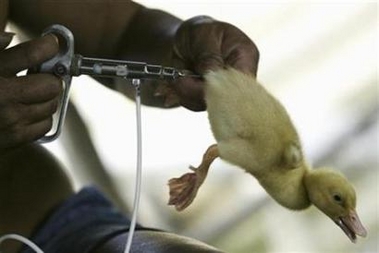A worker injects a duckling with the bird flu vaccine at a duck farm following an outbreak of bird flu, in Panyu district of Guangzhou, south China's Guangdong province, September 18, 2007. Researchers in Singapore have created a handheld device that can detect the H5N1 bird flu virus from throat swab samples in under 30 minutes, raising hopes it will lead to rapid detection and containment of the virus. (Photo: Reuters)
Researchers in Singapore have created a handheld device that can detect the H5N1 bird flu virus from throat swab samples in under 30 minutes, raising hopes it will lead to rapid detection and containment of the virus.
Conventional laboratory tests take around 4 hours, and require machines to first isolate and amplify the virus before it is tested.
Writing in the latest issue of Nature Medicine, the scientists said the new device would allow decentralized testing of the H5N1 virus, especially in countries that lack basic public health resources.
H5N1, a disease found mostly in birds, is endemic in many parts of Asia and experts have warned for years that it could spark a pandemic, killing millions of people, if it learns to jump from person to person.
"The World Health Organisation containment plan aims to stop an epidemic locally in order to prevent a global disaster," the scientists said.
"In the event of a flu epidemic, its rapid containment would depend on the prompt identification of the first cases. But as routine surveillance may be problematic in countries with limited public health resources, low-cost, easy-to-use detection (procedures) would be advantageous."
The all-in-one device is able to isolate, purify and amplify the viral DNA from raw throat swab samples and put it through an H5N1 detection test.
"The answers you will get is: am I infected? If yes, how 'severe' is it?" one of the researchers, Juergen Pipper of Singapore's Institute of Bioengineering and Nanotechnology, wrote in an email to Reuters.
The team ran several hundred tests on the device.
"The accuracy is comparable to conventional equipment, although we are faster and cheaper," Pipper said.
The scientists hope to use the device to test for other viruses, such as SARS, AIDS and hepatitis B.
"In addition, it may be applicable not only to the flu virus, but could be adapted to other infectious agents, and to other bodily fluids like blood, urine or saliva," they said.
(Agencies via CRI.cn September 24, 2007)


